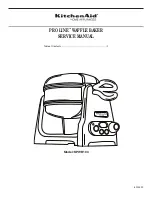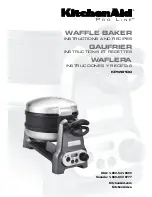
2/ BEFORE THE FIRST USE
•
Take the appliance out of the box.
•
Check if handles are strongly fixed.
•
Remove the plastic and foam protection from trays and each stainless steel element.
•
Check fixations of removable stainless steel trays (n
°
2 - description of elements).
The trays and pyramids can be easily removed from their fixations.
•
Check that the voltage indicated on the appliance is suitable for your installation.
•
Additional option : insert Z system to block the opening to 115
°
(cf. schema
–
Description of elements
–
n
°
2).
•
The baking plates A and B are not interchangeables.
3/ STARTUP
This waffle iron has been protected by a food silicone to prevent the waffles from sticking.
A residual odor can be noticed during the first cooking but will disappear quickly. For this reason, the first cooking of waffles
should be discarded and not eaten.
4/ CONDITIONS OF USE
•
Based on your recipe, prepare your dough. This machine is only designed to cook waffles.
•
The appliance is equipped with a thermostatic control :
•
With a graduation starting at 50
°
C/122
°
F where each line is = 10
°
C/50
°
F.
•
OR with 10 positions. Each level is a multiple of 30°C/86°F. Examples : 4 = 120
°
C/248
°
F ; 5 = 150
°
C/302
°
F
•
Before cooking, preheat the appliance to the temperature requested
•
At least 15-20 minutes are necessary in order to obtain a temperature of +- 180
°
C evenly on cooking plates.
•
Switch button : when the waffle maker reaches the selected temperature, the indicator light goes out (n°6 - description of
elements).
•
Recommended temperature for cooking: between 150°C/302°F and 190°C/374°F.
Recommended temperature depending on the type of waffle.
•
Recommended temperature for re-cooking : 80
°
C/176
°
F during max 30 sec. Only acceptable for Liège waffle.
TIPS
•
A pastry release spray can be applied to quickly and evenly grease baking plates.
•
When using a liquid dough like Brussels waffle :
•
When pouring the dough, fill the baking plate (A or B). Be careful to not overflow the dough over the edges of the
baking plate.
•
After pouring the dough, close the waffle maker and do a complete 180
°
rotary of the machine. This distributes the
dough and sugar evenly.
•
When using a hard dough like Liege waffle, after half of the cooking do a complete 180
°
rotary of the machine. This
distributes the dough and sugar evenly.
•
To remove waffles from baking plates and to avoid burns, we advice to use a « waffle fork ».
•
When there is too much caramel residues in baking plates, place a baking paper on the iron plate A or B and close the waffle
maker : the sugar accumulated on the top plate will flow onto this paper. Repeat this action for the second plate.
•
If a waffle sticks while it is being cooked, it may be due to the appliance which is too hot, too dirty or the coating food has
disappeared. The solutions are :
•
The temperature should be turned down slightly and duration of the cooking increased
•
OR the appliance needs a cleaning (See n°5 - Clean a waffle maker)
•
OR it needs a new food coating (See n°5
–
Cleaning of a waffle maker -> Coating application)
fixations






















